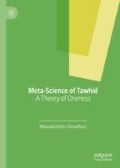Abstract
Total wellbeing is realized only in the Hereafter. The ever-changing wellbeing functions corresponding to all matters of the world-system are simulated along the evolutionary learning events in continuum of historical consciousness from aye to eternity. The similitude of worldly experiences is maintained in the Hereafter in their optimal and steady-state equilibrium attainment of excellence in Heaven and the most degraded levels of perdition in Hell. Such is the blissful and contrary states expected of total wellbeing in the final fulfilment of Heavenly excellence. In this state, unlike the case of a learning mix of attaining Truth while progressively avoiding Falsehood (bad and evil) in the world-system, the total wellbeing of Heaven is perfectly independent and disjoint from the criterion of perdition in Hell. Thereafter, the two criteria—of Truth and Falsehood reach their independent states of evolution in these two cases, respectively. Consequently, there is no unattained state of optimality in knowledge and ‘de-knowledge’. Heaven and Hell are thereby real physical states to be embedded in the optimality and steady-state equilibrium of knowledge and ‘de-knowledge’ in the Hereafter, respectively. Because the moral-material states are attained monotonically, increasing for knowledge embedding, decreasing for ‘de-knowledge’ embedding of abstracto-empirical forms, therefore, the optimal and steady-state embedding of knowledge in Heaven and of ‘de-knowledge’ in Hell mean that such states are physical states of total reality. They are not mere mental states, which Iqbal referred to as human ego (Iqbal 1934).
Access this chapter
Tax calculation will be finalised at checkout
Purchases are for personal use only
Notes
- 1.
All translations and exegeses of the Qur’an are from A. Yusuf Ali (2013). The Meaning of the Holy Quran.
References
All translations and exegeses of the Qur’an are from A. Yusuf Ali (2013). The Meaning of the Holy Quran.
B
Barrow, J. D. (1991). Theories of Everything, the Quest for Ultimate Explanation. Oxford: Oxford University Press.
Buchman, D. (1998). Ghazali, The Niche of Lights. Provo: Brigham Young University Press.
C
Chittick, W. C. (1989). Sufi Path of Knowledge. Albany: State University of New York.
D
Dampier, W. C. (1991). Scientific Philosophy and Its Outlook. In A History of Science and Its Relations with Philosophy and Religion. Cambridge: The Cambridge University Press.
F
Foucault, M. (1972). The Archeology of Knowledge and the Discourse on Language (A. M. Sheridan, Trans.). New York: Harper Torchbooks.
G
Gel’fand, I. M. (1961). Lectures on Linear Algebra. New York: Interscience Publishers, Inc.
Ghazali, I. (1997). The Incoherence of the Philosophers (M. E. Marmura, Trans., p. 217). Provo: Brigham Young University Press.
H
Husserl, E. (1970). The Crisis of European Sciences and Transcendental Phenomenology on Transcendental Ego (D. Carr, Trans.). Evanston: Northwestern University Press.
I
Iqbal, M. (1934). The Reconstruction of Religious Thought in Islam. Oxford: Oxford University Press.
M
Mahomedy, A. C. (2016). Why the Rationalist Foundations of Modern Science Are Unsuitable for Islamic Economics. A thesis submitted in fulfilment of the requirements for the degree of Doctor of Philosophy (PhD) in Economics, School of Accounting, Economics, and Finance, College of Law and Management Studies, University of Kwazulu-Natal, South Africa.
N
Ng, Y.-K. (1986). Mesoeconomics: A Micro-Macro Analysis. New York: Harvester Wheatsheaf.
R
Ramsey, F. P. (1928). A Mathematical Theory of Saving. The Economic Journal, 38(152), 543–559.
W
Waliullah, S. (n.d.). Hujjat Allah Al-Baligah. Beirut: Dar Al-Marifat.
Wilson, E. O. (1998). Consilience, Unity of Knowledge. New York: Vantage Books.
Author information
Authors and Affiliations
Rights and permissions
Copyright information
© 2019 The Author(s)
About this chapter
Cite this chapter
Choudhury, M.A. (2019). The Importance of Inter-causal Symbolism in Meta-science of Tawhid. In: Meta-Science of Tawhid. Palgrave Macmillan, Cham. https://doi.org/10.1007/978-3-030-21558-3_15
Download citation
DOI: https://doi.org/10.1007/978-3-030-21558-3_15
Published:
Publisher Name: Palgrave Macmillan, Cham
Print ISBN: 978-3-030-21557-6
Online ISBN: 978-3-030-21558-3
eBook Packages: Religion and PhilosophyPhilosophy and Religion (R0)

